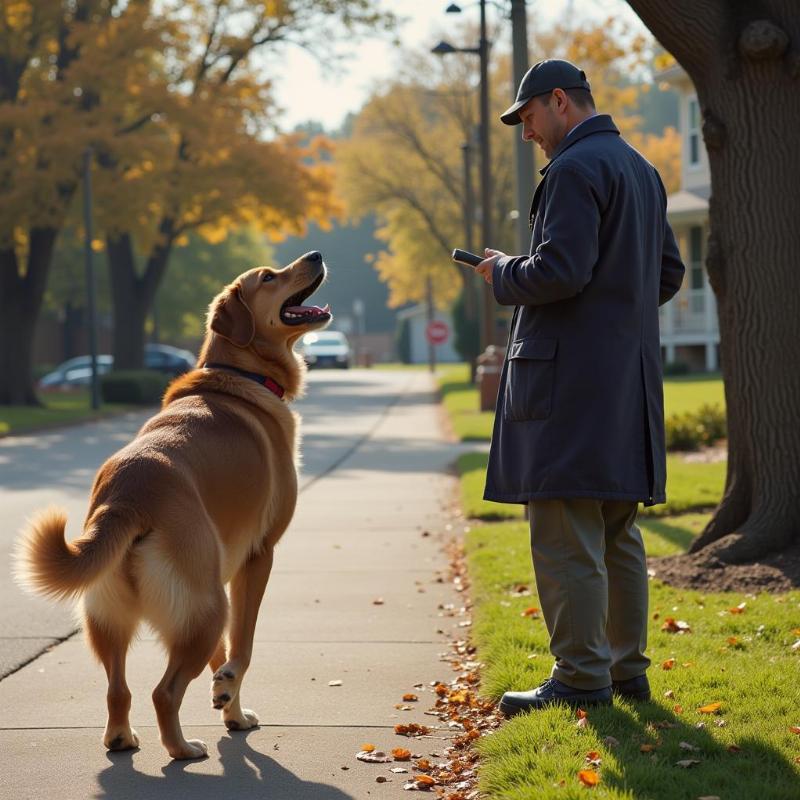Teaching your dog to be quiet is a valuable skill for any owner. A barking dog can be disruptive, frustrating, and even cause tension with neighbors. But with patience, consistency, and the right approach, you can teach your dog the “quiet” command and enjoy a more peaceful home. This guide will provide you with practical steps and expert advice on how to effectively silence your furry friend when needed.
Understanding Why Your Dog Barks
Before diving into training, it’s essential to understand why your dog is barking. Dogs bark for various reasons, including:
- Territorial barking: Protecting their home or yard from perceived intruders.
- Alarm barking: Alerting you to something unusual, like a strange noise.
- Attention-seeking barking: Wanting your attention or a treat.
- Playful barking: Excited barking during playtime.
- Anxiety or boredom barking: Barking due to stress, loneliness, or lack of stimulation.
Identifying the underlying cause of your dog’s barking can help you tailor your training approach for maximum effectiveness.
 chó sủa
chó sủa
Teaching the “Quiet” Command: A Step-by-Step Guide
- Capture the quiet: Wait for a moment when your dog naturally stops barking, even if it’s just a brief pause. Immediately say “Quiet” in a firm, clear voice.
- Reward the silence: As soon as your dog remains quiet, even for a second or two, reward them with a small treat and praise.
- Repeat and reinforce: Continue to practice this capturing and rewarding process, gradually increasing the duration of silence required before giving the treat.
Addressing Underlying Issues
Training your dog to be quiet is more effective when you address the root cause of their barking. If your dog barks excessively due to anxiety or boredom, consider:
- Providing more exercise and mental stimulation: A tired dog is a well-behaved dog. Regular walks, playtime, and puzzle toys can help. how to train an overexcited dog
- Creating a safe and secure environment: A comfortable den or crate can provide a sense of security for anxious dogs.
- Desensitization and counter-conditioning: Gradually exposing your dog to the triggers that cause barking, while pairing it with positive reinforcement. distance increasing signals in dogs
Troubleshooting Common Challenges
- My dog ignores the “Quiet” command: Ensure you’re using a clear and consistent command, and that your dog isn’t overly stimulated or distracted.
- My dog only stops barking momentarily: Gradually increase the duration of silence required for a reward.
- My dog starts barking again after being quiet: Be patient and consistent with your training. It takes time for dogs to learn new behaviors. why my dog doesn’t listen to me
Expert Insights
Dr. Emily Carter, a certified veterinary behaviorist, advises, “Consistency is key when teaching any command, including ‘Quiet.’ Make sure everyone in the household uses the same command and follows the same training approach.”
Conclusion
Teaching your dog to be quiet requires patience, consistency, and understanding. By addressing the underlying causes of barking and following the steps outlined in this guide, you can effectively teach your dog the “quiet” command and create a more peaceful environment for both of you. Remember to reward good behavior, be consistent, and seek professional help if you’re struggling. Mastering the “quiet” command can significantly improve your relationship with your furry companion. how to teach a dog quiet
FAQ
- How long does it take to teach a dog the quiet command? It varies depending on the dog, but with consistent training, you should see progress within a few weeks.
- What if my dog barks aggressively? Consult with a certified professional dog trainer or veterinary behaviorist for guidance.
- Can I use a bark collar? While bark collars can be effective, it’s important to use them responsibly and under the guidance of a professional. Positive reinforcement methods are generally preferred.
- Is it okay to ignore my dog’s barking? Ignoring attention-seeking barking can be helpful, but it’s important to address other types of barking to ensure your dog’s well-being.
- Should I punish my dog for barking? Punishment is generally not effective and can even worsen barking behavior. Focus on positive reinforcement and addressing the underlying cause.
Beautdogs.us is your premier destination for all things dog-related in the US. We offer expert advice on dog breeds, care, training, and product recommendations. Whether you’re a new dog owner or a seasoned pro, Beautdogs.us is your trusted resource for comprehensive and engaging information. Contact us today for all your canine needs! Email: [email protected], Phone: +1 501-555-7529. Visit Beautdogs.us for more helpful tips and resources.